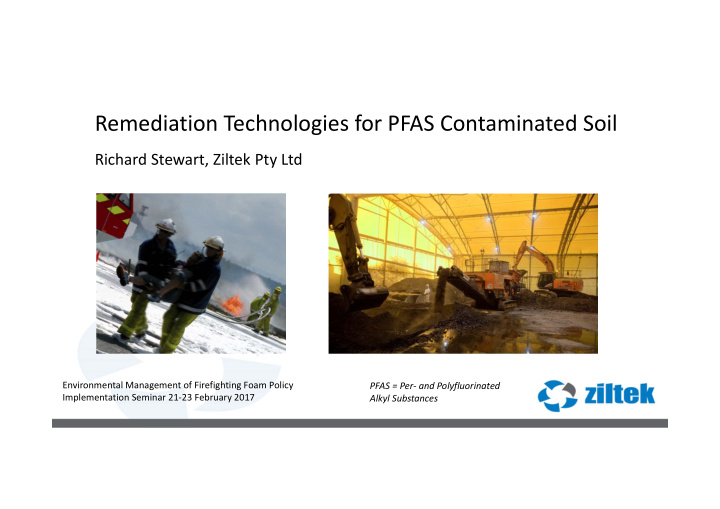



Remediation Technologies for PFAS Contaminated Soil Richard Stewart, Ziltek Pty Ltd Environmental Management of Firefighting Foam Policy PFAS = Per ‐ and Polyfluorinated Implementation Seminar 21 ‐ 23 February 2017 Alkyl Substances
PFAS contaminated soil ? • Construction • Site remediation • Spill clean up • Source removal PFAS contaminated soil
Landfill disposal October 2016
Landfill disposal October 2016 ~$150 to $550 per tonne
Soil treatment technologies Technology Feasible for PFAS in soil? Commercially used in Australia to treat PFAS in soil? Biodegradation No No Chemical oxidation/reduction Maybe No Thermal desorption Maybe Indirect Incineration Yes Limited Soil washing Yes No Onsite encapsulation Yes No Solidification Maybe No Emerging technologies (e.g. sonication, Maybe No electrochemistry, in situ sequestration) Immobilisation Yes Yes
What is immobilisation? Adding a reagent to bind up the • contaminants – also called ‘chemical fixation’, ‘stabilisation’ PFOS Reduces leaching and risk to human • health and the environment Proprietary reagents for PFAS • include RemBind™ and MatCare™ Powdered activated carbon has also • been tested
What is immobilisation? Adding a reagent to bind up the • contaminants – also called ‘chemical fixation’, ‘stabilisation’ PFOS Reduces leaching and risk to human • health and the environment Proprietary reagents for PFAS • include RemBind™ and MatCare™ Powdered activated carbon has also • ~$40 to $150 been tested in trials per tonne
Why use immobilisation? Ex ‐ situ treatment In ‐ situ treatment Leave in place Onsite reuse Landfill ‐ reduced hazard
RemBind – an Australian example of PFAS immobilisation in soil A powdered reagent that binds to PFAS in soil to • prevent leaching Has passed extensive independent testing by • government airport authorities Has been used commercially to treat PFAS • contaminated soil in Australia and the USA
How does it work? ‐ +++++++ ‐ Point of zero charge > pH 9.1 ‐ ‐ Electrostatic Interactions + + + + Hydrophobic Interactions Aluminium Hydroxide (Amorphous) Physical Van der Waals Binding Activated Carbon
How is it applied? Add RemBind to soil at ~1% to 5% by weight • Adjust to ~30% moisture • Wait 24 hrs for the binding reaction to occur • Key success factor = optimal surface area contact •
Treating 15,000 m 3 of contaminated soil using RemBind, Sydney, Australia
In ‐ situ application
How effective is RemBind at binding PFAS?
How effective is RemBind at binding PFAS?
How effective is RemBind at binding PFAS?
How effective is RemBind at binding PFAS?
How stable is the binding reaction? Because RemBind doesn’t destroy the contaminants, it is • critical to prove the long term stability of the binding Multiple Extraction Procedure (USEPA 1320) simulates 1,000 • yrs of acid rain conditions in an improperly designed landfill Site 1 ‐ RemBind Plus Treatment Leach EP 1 2 3 4 5 6 7 8 9 PFOS 0.04 0.02 <0.02 <0.02 0.02 <0.02 <0.02 <0.02 <0.02 <0.02 ug/L pH 3 5 5 5 5 5 5 5 5 5
How effective is RemBind at binding PFAS?
96% reduction 90% reduction 99% reduction 98% reduction PFOS PFOS PFOS PFOS
Commercial application of RemBind for treatment of PFAS in soil in Australia • In December 2015, RemBind was used to remediate 1,000 tonnes of PFAS soil from two airport sites in Australia • Used a purpose ‐ built burial cell with a pure RemBind liner and cap • Regulatory approval for landfill disposal was granted with no ongoing remediation requirements Regulatory target = 0.2 µg/L
January 2017, Cape Cod, Massachusetts, USA
Summary Current options for PFAS soil treatment in Australia: • Landfill disposal • Immobilisation • Incineration and thermal desorption? • Other technologies under development, this space • is moving quickly! The regulatory environment is still unclear. •
Recommend
More recommend